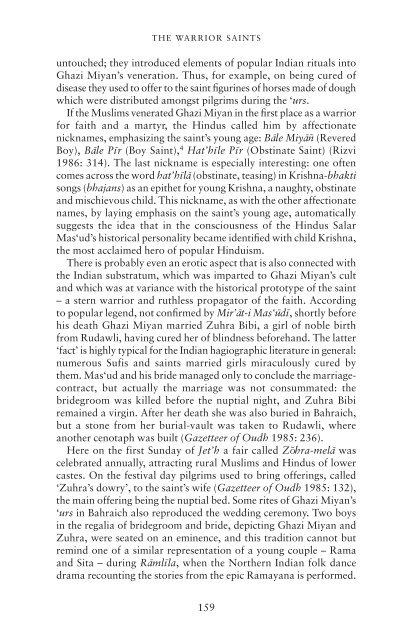Muslim Saints of South Asia: The eleventh to ... - blog blog blog
Muslim Saints of South Asia: The eleventh to ... - blog blog blog
Muslim Saints of South Asia: The eleventh to ... - blog blog blog
Create successful ePaper yourself
Turn your PDF publications into a flip-book with our unique Google optimized e-Paper software.
THE WARRIOR SAINTS<br />
un<strong>to</strong>uched; they introduced elements <strong>of</strong> popular Indian rituals in<strong>to</strong><br />
Ghazi Miyan’s veneration. Thus, for example, on being cured <strong>of</strong><br />
disease they used <strong>to</strong> <strong>of</strong>fer <strong>to</strong> the saint figurines <strong>of</strong> horses made <strong>of</strong> dough<br />
which were distributed amongst pilgrims during the ‘urs.<br />
If the <strong>Muslim</strong>s venerated Ghazi Miyan in the first place as a warrior<br />
for faith and a martyr, the Hindus called him by affectionate<br />
nicknames, emphasizing the saint’s young age: Bāle Miyāñ (Revered<br />
Boy), Bāle Pīr (Boy Saint), 4 Hat’hīle Pīr (Obstinate Saint) (Rizvi<br />
1986: 314). <strong>The</strong> last nickname is especially interesting: one <strong>of</strong>ten<br />
comes across the word hat’hīlā (obstinate, teasing) in Krishna-bhakti<br />
songs (bhajans) as an epithet for young Krishna, a naughty, obstinate<br />
and mischievous child. This nickname, as with the other affectionate<br />
names, by laying emphasis on the saint’s young age, au<strong>to</strong>matically<br />
suggests the idea that in the consciousness <strong>of</strong> the Hindus Salar<br />
Mas‘ud’s his<strong>to</strong>rical personality became identified with child Krishna,<br />
the most acclaimed hero <strong>of</strong> popular Hinduism.<br />
<strong>The</strong>re is probably even an erotic aspect that is also connected with<br />
the Indian substratum, which was imparted <strong>to</strong> Ghazi Miyan’s cult<br />
and which was at variance with the his<strong>to</strong>rical pro<strong>to</strong>type <strong>of</strong> the saint<br />
– a stern warrior and ruthless propaga<strong>to</strong>r <strong>of</strong> the faith. According<br />
<strong>to</strong> popular legend, not confirmed by Mir’āt-i Mas‘ūdī, shortly before<br />
his death Ghazi Miyan married Zuhra Bibi, a girl <strong>of</strong> noble birth<br />
from Rudawli, having cured her <strong>of</strong> blindness beforehand. <strong>The</strong> latter<br />
‘fact’ is highly typical for the Indian hagiographic literature in general:<br />
numerous Sufis and saints married girls miraculously cured by<br />
them. Mas‘ud and his bride managed only <strong>to</strong> conclude the marriagecontract,<br />
but actually the marriage was not consummated: the<br />
bridegroom was killed before the nuptial night, and Zuhra Bibi<br />
remained a virgin. After her death she was also buried in Bahraich,<br />
but a s<strong>to</strong>ne from her burial-vault was taken <strong>to</strong> Rudawli, where<br />
another cenotaph was built (Gazetteer <strong>of</strong> Oudh 1985: 236).<br />
Here on the first Sunday <strong>of</strong> Jet’h a fair called Zŏhra-melā was<br />
celebrated annually, attracting rural <strong>Muslim</strong>s and Hindus <strong>of</strong> lower<br />
castes. On the festival day pilgrims used <strong>to</strong> bring <strong>of</strong>ferings, called<br />
‘Zuhra’s dowry’, <strong>to</strong> the saint’s wife (Gazetteer <strong>of</strong> Oudh 1985: 132),<br />
the main <strong>of</strong>fering being the nuptial bed. Some rites <strong>of</strong> Ghazi Miyan’s<br />
‘urs in Bahraich also reproduced the wedding ceremony. Two boys<br />
in the regalia <strong>of</strong> bridegroom and bride, depicting Ghazi Miyan and<br />
Zuhra, were seated on an eminence, and this tradition cannot but<br />
remind one <strong>of</strong> a similar representation <strong>of</strong> a young couple – Rama<br />
and Sita – during Rāmlīla, when the Northern Indian folk dance<br />
drama recounting the s<strong>to</strong>ries from the epic Ramayana is performed.<br />
159


